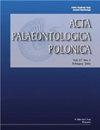摩洛哥反阿特拉斯晚泥盆世大量堆积的菊石极其丰富
IF 1.9
3区 地球科学
Q2 PALEONTOLOGY
引用次数: 1
摘要
摩洛哥反阿特拉斯晚泥盆世大量堆积的菊石极其丰富。古生物学报67 (X): xxx-xxx。东部的反阿特拉斯以其高度化石化的泥盆纪岩石而闻名。在Tafilalt和Maïder的许多地方,菊石以形成岩石的数量出现。这项研究解决了在一个标准化区域以及整个Tafilalt和Maïder盆地中保存了多少氨石的问题,以及这些大规模事件是如何形成的。对来自Tafilalt和Maïder的五个样本进行了分析。对其中所含的菊石进行了制备、测量和计数,作为估计Anti-Atlas东部各自法门期地层中保存的菊石总数及其生物量的数量级的基础。2个样品在地层学上属于下法门统,2个样品属于中法门统,1个样品属于上法门统。对于这些样品,1 km2的标准化面积和100 mm的层厚的估计值介于19.9×10 9和1.25×10 10之间。整个研究区逆变形面积为15 512.5 km 2,沉积物厚度为100 mm,估计氨螺数量为30.9×10 13 ~ 19.4×10 14只,年累积量为15.4×10 9 ~ 97.1×10 9只。这相当于整个研究区内的年总古生物量在25 954 t ~ 47 058 t之间,1 km2范围内的年总古生物量在1.67 t ~ 3.03 t之间。根据这些结果和样品的大小分布,讨论了早、中法门世小而丰富的亚球形菊石的生态作用,并估计了其繁殖率。在早期法门纪沉积物中,一只成年雌鱼产约230个卵,cheiloceratids和小型maeneceratids在氨类繁殖率中处于较低水平。本文章由计算机程序翻译,如有差异,请以英文原文为准。
Extreme abundance of ammonoids in mass accumulations from the Late Devonian of the Moroccan Anti-Atlas
Extreme abundance of ammonoids in mass accumulations from the Late Devonian of the Moroccan Anti-Atlas. Acta Palaeontologica Polonica 67 (X): xxx–xxx. The eastern Anti-Atlas is renowned for its highly fossiliferous outcrops of Devonian rocks. Ammonoids occur in rock-forming numbers at many localities in the Tafilalt and Maïder. This study addresses the questions of how many ammonoids are preserved within a standardized area as well as over the whole Tafilalt and Maïder basins, and how these mass occurrences formed. Five samples from the Tafilalt and Maïder were analysed. The ammonoids contained therein were prepared, measured and counted as a base for estimates of the orders of magnitude of the total number of preserved ammonoids and their biomass within the respective Famennian strata in the eastern Anti-Atlas. Two samples were stratigraphically assigned to the lower Famennian, two samples to the middle Famennian and one sample to the upper Famennian. For these samples, estimates for a standardized area of 1 km 2 and a layer thickness of 100 mm lie between 19.9×10 9 and 1.25×10 10 ammonoids. The estimated numbers for the whole study area with a retrodeformed size of 15 512.5 km 2 and a sediment thickness of 100 mm, ranges from 30.9×10 13 to 19.4×10 14 ammonoids and a annual accumulation of 15.4×10 9 to 97.1×10 9 ammonoid conchs. This corresponds to a annual total palaeo-biomass that ranges from 25 954 t to 47 058 t within the whole study area and from 1.67 t to 3.03 t within an area of 1 km 2 . Based on these results and size-distribution in the samples, the ecological role of the small and highly abundant, subspherical ammonoids from the early and middle Famennian is discussed and reproductive rates are estimated. With ca. 230 eggs produced by an adult female, cheiloceratids and small maeneceratids from the early Famennian deposits are at the lower end of ammonoid reproductive rates.
求助全文
通过发布文献求助,成功后即可免费获取论文全文。
去求助
来源期刊

Acta Palaeontologica Polonica
地学-古生物学
CiteScore
2.80
自引率
5.60%
发文量
36
审稿时长
12.5 months
期刊介绍:
Acta Palaeontologica Polonica is an international quarterly journal publishing papers of general interest from all areas of paleontology. Since its founding by Roman Kozłowski in 1956, various currents of modern paleontology have been represented in the contents of the journal, especially those rooted in biologically oriented paleontology, an area he helped establish.
In-depth studies of all kinds of fossils, of the mode of life of ancient organisms and structure of their skeletons are welcome, as those offering stratigraphically ordered evidence of evolution. Work on vertebrates and applications of fossil evidence to developmental studies, both ontogeny and astogeny of clonal organisms, have a long tradition in our journal. Evolution of the biosphere and its ecosystems, as inferred from geochemical evidence, has also been the focus of studies published in the journal.
 求助内容:
求助内容: 应助结果提醒方式:
应助结果提醒方式:


